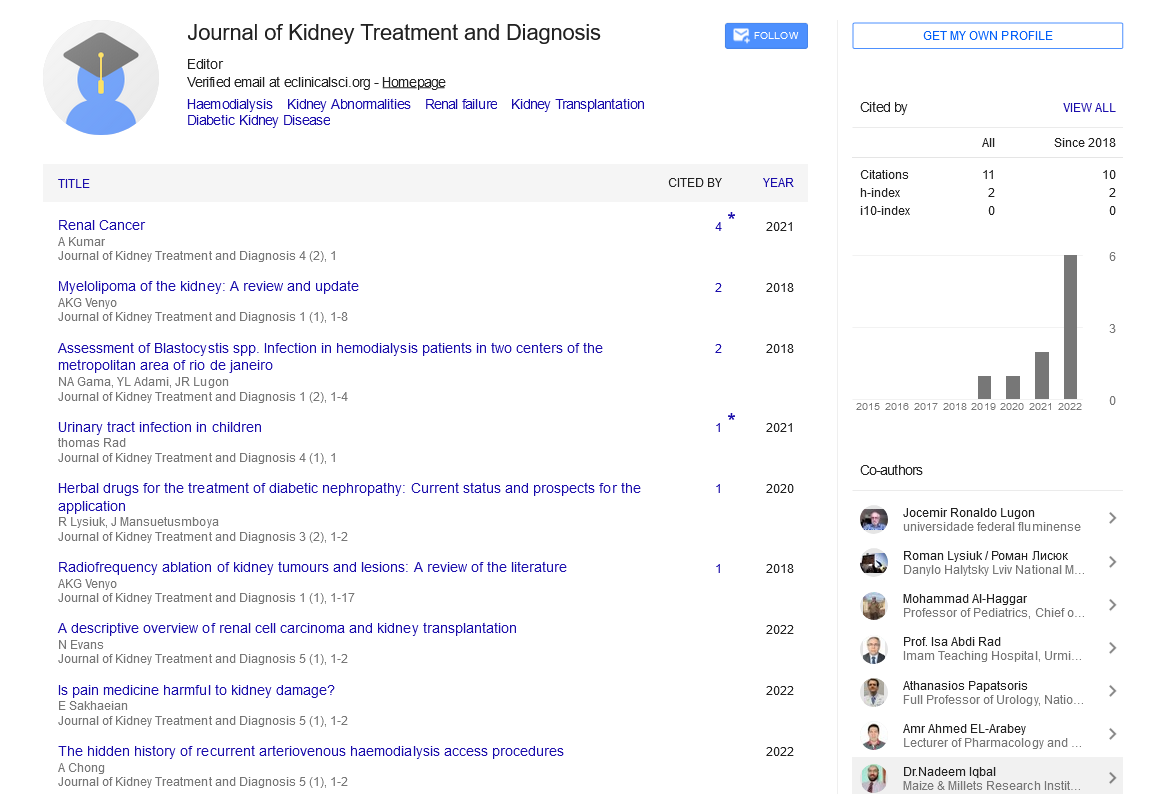Evaluation of laboratory measurements for the clinical assessment of chronic kidney disease
Received: 08-Nov-2017 Accepted Date: Nov 13, 2017; Published: 29-Nov-2017
This open-access article is distributed under the terms of the Creative Commons Attribution Non-Commercial License (CC BY-NC) (http://creativecommons.org/licenses/by-nc/4.0/), which permits reuse, distribution and reproduction of the article, provided that the original work is properly cited and the reuse is restricted to noncommercial purposes. For commercial reuse, contact reprints@pulsus.com
Chronic kidney disease (CKD) earlier used to called as chronic renal failure (CRF). Chronic kidney disease (CKD) is having higher rate of morbidity and mortality. CKD is a globally recognized public health problem.
It involves all degrees of decreased renal function, progressively leads from damaged–at risk through mild, moderate, and ultimately end-stage kidney failure. Most patients are asymptomatic until the disease has significantly progressed, they remain unaware of the condition. Thus, it is essential to have clinical guidelines, aimed at early detection, evaluation, diagnosis, and treatment for slowing down the progression of this condition.
CKD is more common in the elderly population. Whereas in younger patients with CKD typically experience progressive loss of renal function, about 30% of patients over the age of 65 years with CKD have stable disease [1]. CKD is recognized for its association with an increased risk of cardiovascular disease and end-stage renal disease (ESRD). Major cause for chronic kidney disease may be by diabetes, high blood pressure and other disorders. Early detection and treatment can often useful to keep chronic kidney disease from getting worse. When kidney disease progresses, it may eventually lead to end-stage renal disease (ESRD), which requires dialysis or a kidney transplant to sustain life (Table 1).
| Stage | eGFR value | Clinical symptoms associated with CKD |
|---|---|---|
| Stage 1 – Structural or functional abnormalities of Kidney with normal kidney function | From 90-120 | Hypertension, urinary tract infections, abnormal findings in Urine |
| Stage 2 – Structural or functional abnormalities of Kidney with mild loss of kidney function | From 60–89 | Hypertension, urinary tract infections, abnormal findings in Urine |
| Stage 3a – Mild to moderate loss of kidney function | From 45–59 | Hypertension, urinary tract infections, abnormal findings in Urine |
| Stage 3b – Moderate to severe loss of kidney function | From 30–44 | Anemia, malnutrition, bone problems, abnormal nerve sensations, reduced mental functioning |
| Stage 4 – Severe loss of kidney function | From 15–29 | Swelling and puffiness, anemia, decreased appetite and blood and urine abnormalities |
| Stage 5 – Kidney failure, also known as end stage renal disease (ESRD) | Less than 15 | difficulty breathing , decreased appetite, fatigue, mental symptoms and blood and urine abnormalities |
Table 1: Stages of Chronic Kidney Disease.
Based on GFR estimation, the National Kidney Foundation has classified CKD into five stages.
Chronic kidney disease (CKD) is classified according to the degree of kidney damage – measured by the level of proteinuria – and the decline in glomerular filtration rate. The most severe form is end-stage renal disease. CKD define as either presence of kidney damage or a decreased glomerular filtration rate (GFR) which is less than 60 mL/min/1.73 m2 for at least 3 months. Whatever the underlying cause, once the loss of nephrons occurs and reduction of functional renal mass reaches to a certain point, the remaining nephrons begin a process of irreversible sclerosis which leads to a progressive decline in the GFR [2].
REFERENCES
- O’Hare AM, Choi AI, Bertenthal D, et.al. Age affects outcomes in chronic Kidney disease. J Am Soc Nephrol. 2007;18(10):2758-65.
- Schnaper HW. Remnant Nephron physiology and the progression of chronic kidney disease. Pediatr Nephrol. 2014;29(2):193-202.
- National Kidney Foundation. K/DOQI Clinical practice guidelines for chronic kidney disease: Evaluation, classification, and stratification. Am J Kidney Dis. 2002;39:S1-S266.
- Chew JS, Saleem M, Florkowski CM, et al. Cystatin C-a paradigm of evidence based laboratory medicine. Clin Biochem Rev. 2008;29:47–62.
- Bhavsar NA, Appel LJ, Kusek JW, et.al. Comparison of measured GFR, Serum creatinine, Cystatin C and beta trace protein to predict ESRD in African Americans with hypertensive CKD. Am J Kidney Dis. 2011;58(6):886-93.
- Inker LA, Tighiouart H, Coresh J,et.al. GFR estimation using β-Trace Protein and β2-Microglobulin in CKD. Am J Kidney Dis. 2016;67(1):40–8.
- Bolignano D, Coppolino G, Campo S, et.al. Neutrophil gelatinase associated lipocalin in patients with autosomal dominant polycystic kidney disease. Am J Nephrol. 2007;27(4):373-8.
- Sabbisetti VS, Waikar SS, Antoine DJ, et.al. Blood kidney injury molecule-1 is a biomarker of acute and chronic kidney injury and predicts progression to ESRD in type I diabetes. J Am Soc Nephrol. 2014;25(10):2177-86.
- Hanai K , Babazono T, Nyumura I, et.al. Asymmetric dimethylarginine is closely associated with the development and progression of nephropathy in patients with type 2 diabetes. Nephrol Dial Transplant. 2009;24(6):1884-8.
- Ravani P, Tripepi G, Malberti F, et al. Asymmetrical dimethylarginine predicts progression to dialysis and death in patients with chronic kidney disease: a competing risks modeling approach. J Am Soc Nephrol. 2005;16(8):2449-55.
- Wasung ME, Chawla LS, Madero M. Biomarkers of renal function, which and when? Clin Chim Acta. 2015;438:350-7.
- Steubl D, Block M, Herbst V, et al.Plasma Uromodulin Correlates With Kidney Function and Identifies Early Stages in Chronic Kidney Disease Patients. Medicine (Baltimore). 2016;95(10):e3011.
- Khurana R, Ranches G, Schafferer S, et.al. Identification of urinary exosomal noncoding RNAs as novel biomarkers in chronic kidney disease. RNA. 2017;23(2):142-52.





